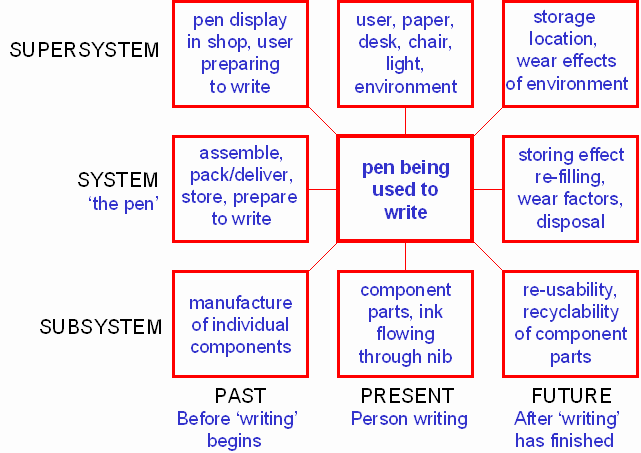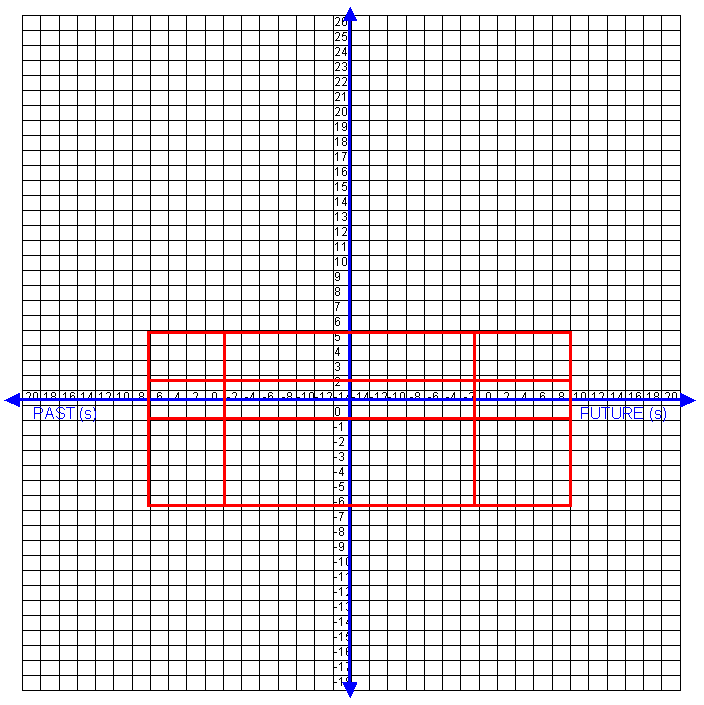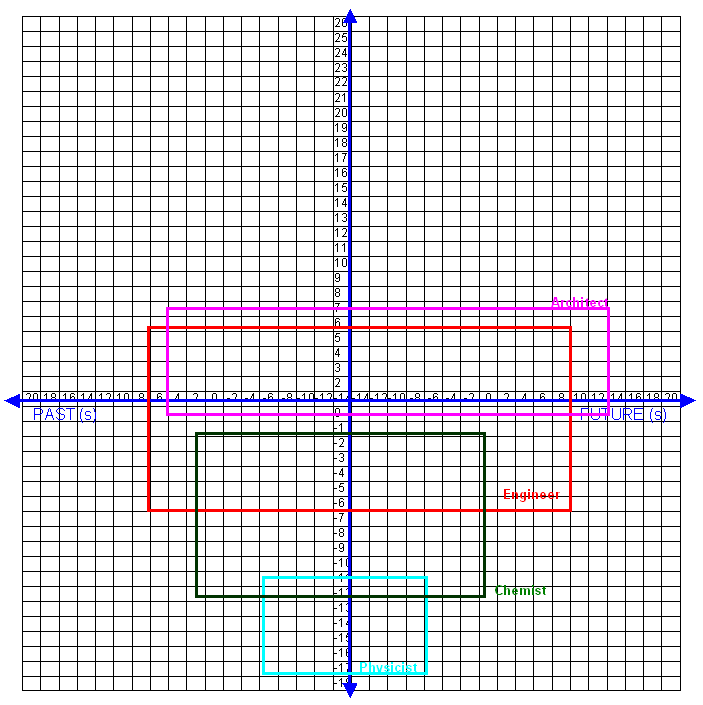System Operator Tutorial - 1) 9-Windows On The World
Editor | On 11, Sep 2001
Darrell Mann
Industrial Fellow
Department of Mechanical Engineering
University of Bath
Bath, BA2 7AY, UK
Phone: +44 (1225) 826465
Fax: +44 (1225) 826928
E-mail: D.L.Mann@bath.ac.uk
Introduction
This article forms the first of a series providing novel perspectives on the interpretation and application of the TRIZ ‘system operator’ or ‘9-windows’ tool.
While the system operator has existed for some time within TRIZ literature (Reference 1), it is not clear whether the concept was first derived by TRIZ researchers or not. Certainly a form of the 9-windows – in actual fact, as we will see in the third article, a more comprehensive form – was included in very early NLP literature (Reference 2). Irrespective of its roots, however, the overall theme of the article series is to highlight the importance of the operator during just about every aspect of TRIZ usage, from initial definition through to evaluation of best solutions, and for all kinds of situations both technical and non-technical.
In this first article we attempt to relate the system operator to a global space and time framework. Rather than this being an attempt to draw any all-embracing philosophical conclusions, our theme is merely to highlight the different perspectives of different industry and business sectors during application of the system operator tool.
System Operator Concept
The System Operator ‘tool’ is a simple means of helping users to think in terms of TIME and SPACE. The basic principle of operation divides ‘the world’ into nine segments as shown in Figure 1. The central box of the nine – system, present – is the one our brains naturally migrate to whenever we are given a problem situation. In other words, asked to think about ‘designing a better pen’, our brains are likely to immediately conjure up the image of a pen (‘the system’) being used to write (‘the present’). What the system operator tool is trying to get us to do is also think about the pen in the bigger (‘super-system’) context – the person holding the pen, the paper, the desk, etc; the smaller (‘sub-system’) context – the components of the pen, the ink molecules, etc; the pen in the past – manufacture, shipping, un-packing, preparing to write, etc; and the pen in the future – what happens to the pen immediately after we’ve finished writing, right through to it’s disposal after it has run out. Figure 2 illustrates some of the main time and space features the we might like to consider when thinking more completely about the design of a pen. The point of this exercise is to help us overcome the psychological inertia (3) of present and system level only thinking.
Figure 1: ‘9-Windows’ of the System Operator
From a ‘pen design’ perspective, the system operator is trying to encourage us to think in a much more holistic way about our design task; thus designing a pen is not just about what happens when a user is writing with it, but about all of the other aspects shown in Figure 2 (and others we might include if we were really in the business of designing pens).
Figure 2: Example System Operator Picture for ‘Pen Design’
The system operator concept is – or at least should be – used throughout the problem solving process (note: we’ll use ‘problem solving’ as a short-hand here for the whole problem definition, problem solving, opportunity finding, opportunity exploiting creativity spectrum). We should be using it when we are looking for resources, identifying constraints, specifying the design requirements (see Reference 4 for example) during the problem definition process, we should be using it during idea generation – see the red-eye case study (5) illustrating how we use the system operator to focus our thinking when connecting TRIZ solution triggers to our problem situation – and we should also be using it when evaluating our solutions.
An Alternative Perspective
The 9-windows of the system operator offer a simple and effective way of encouraging problem solvers to see their problem situation from different perspectives. The tool in its 9-windows form is, however, relatively crude in many senses. This is acutely evident when, for example, using the ‘past’ or ‘future’ triggers to prompt the problem owner to think about the problem in terms of time. Thus in the pen context from above, ‘future’ might mean a fraction of a second – e.g. putting the pen down – or it might mean several years – e.g. bio-degradation in a land-fill.
A simple way of encapsulating this kind of breadth of consideration is the expanded system operator idea first presented in Reference 4 and reproduced here in Figure 3.
Figure 3: Expanded Multi-Screen System Operator
Viewed next to the ‘object segmentation’ evolution trend uncovered by TRIZ researchers, this kind of re-segmentation is an obvious step. The trend would further suggest that the segmented picture ultimately transforms into a continuum for both time and space considerations. In terms of ‘space’ such a continuum is analogous to a movie camera ‘zooming in and zooming out’ on the problem. In terms of ‘time’, this author has come across several highly creative individuals who effectively ‘run a movie’ in their minds, tracking the problem situation from its very beginning through to its final end. In fact the movie image seems to be quite an effective one for combined thinking in space and time – with the film running through time and the camera image focusing in or out on micro detail or macro scenery.
An ‘All-Encompassing’ Alternative Perspective
Taking this expanded segmentation idea a little further takes us towards a much more holistic map of the world. A ‘complete’ (as we know it today anyway!) map of space and time might look something like the picture drawn in Figure 4. Sticking with the idea of space being represented up and down a vertical axis and time progressing along a horizontal axis with the past disappearing off to the left, and the future progressing across to the right, as with the 9-Windows, but now expanding those axes to their limits, the figure shows a big time-space framework. The borders of our framework have been drawn to start with the big bang about 10 billion years ago, and an assumption that the future will last as long if not longer (no-one said the thing had to be symmetrical, right?), and, in terms of SPACE, to zoom in to the structure of a proton or electron, and right out to the size of the whole mass of galaxies spawned by the big bang.
The idea takes at least a part of its inspiration from the work of Charles and Ray Eames (Reference 6) and their seminal images of how our perspectives change when we zoom in and out from our very human level perspective of the world around us. Like the Eames’ a logarithmic scale has been used. Firstly as a way of compacting a large space-time information onto a small map, but also because, as many investigators have noticed, our brains are rather better at registering order of magnitude changes than they are small incremental changes.
The figure has been drawn using meter and second scales, with some reference points as a guide – with, for example a year being just over 3×107 seconds, and the emergence of life on earth taking place around 4 billion years (just over 1×1017 seconds) ago.
PHYSICAL DIMENSION (10x m)
Figure 4: Comprehensive Time-Space Map
Taking this framework as our start point, we might begin to see how different scientific disciplines see their territory. A mechanical engineer, for example, is generally speaking dealing with objects designed and operated at the ‘human’ scale. In terms of space, the ‘system’ is thus likely to be confined to a relatively small range of geometric dimensions. Drawing this in terms of the 9-windows, the sub-system window might see the engineer zooming-in to micro-level consideration of things like tribological effects operating at or around the micron-scale, and zooming-out maybe two or three orders of magnitude to the surrounding environment. In terms of time, the ‘present’ is likely to mean fractions of seconds – e.g. thinking about transient effects – and a time scale of anything less than a millisecond is unlikely to have any apparent meaning. The ‘past’ and ‘future’ horizons are likely to be measured in terms of up to a few years – e.g. thinking about reliability issues.
Thus a mechanical engineers perspective of the 9-windows is likely to look something like that shown in Figure 5.
img
PHYSICAL DIMENSION (m)
Figure 5: Typical Mechanical Engineers 9-Windows Map of the Space-Time Territory
On the other hand – and here is the main point – other engineering or scientific disciplines are likely to have different time and space definitions of what super-system, system, sub-system, past, present and future might mean to them. Thus a chip designer is increasingly interested in time measurements of 10-9 or less – and so to them the line denoting the difference between ‘present’ and ‘future’ might be drawn much closer to the central axis, and the idea of thinking of ‘past’ or ‘future’ in terms of years might seem ridiculous. The chip designer space-time map might look something like the picture shown in Figure 6.
img
PHYSICAL DIMENSION (m)
Figure 6: Typical 9-Windows Perspectives Map of the Space-Time Territory
Likewise, the map drawn by a cosmologist or an archeologist or a biologist or a chemist or a physicist, or a manager running a department in an organisation will be coloured by different perspectives. This is not to say that any of them are wrong, merely that a) they are different, and that b) in each case they are likely to define their 9 (or however many) window boundaries at different places. Vive la difference.
Furthermore, we are not saying either, of course, that we should all be thinking about the big bang when we’re trying to design a new pen, far from it. What such a time-space map it is trying to do is get us to recognise that a) the actual world is much bigger than our personal perspectives on it, and, b) more importantly, that each of us has a potentially different way of thinking about where the boundaries are, and that someone else’s perspective may very well help us to solve our problem. As we will see next time, this is particularly relevant as our knowledge heads further and further into the sub-system.
The ‘9-Windows’ System Operator tool is a very effective way of encouraging problem solvers to recognise the importance of and to think in terms of TIME and SPACE. It should be there in our minds throughout our use of TRIZ if we are to get the most out of the method. The new CreaTRIZÔ (7) software is designed to help problem solvers do this.
It is, however, a relatively crude segmentation of a continuous situation. Some people seem to think naturally in this continuous ‘zooming-in, zooming-out’ film-like kind of way, the rest of us still need some help.
‘The map is not the territory’ is a commonly described statement in the context of our frequent failure to effectively solve problems. The difference between the actuality of a situation and our personal perception of that actuality is often significant. This is an area we will cover in more detail in the third article in the series. We have seen here, however, how the 9-windows concept is a very effective tool for getting us to think in terms of time and space, but that it is also a way, if we’re not careful, of also altering our map of the territory; the ‘territory’ is continuous in both time and space; it is not a series of window segments; the ‘territory’ is usually also much bigger than even our 9-windows perspective.
Our brains seem to work naturally over only a small number of orders of magnitude of either size or time at a given time. The 9-Windows idea is useful in helping us to jump deliberately from one mind-set to another.
As we all take on an increasingly holistic (a word already becoming something of a cliché) view, our awareness of the size and scope of the map is likely to expand such that we look at much more of the ‘complete’ picture.
In the next article, we will examine how the system operator can help us to think more effectively about the way we look at problems from the point of view of our ‘viewing perspective’. Normally we draw the 9 (or however many) boxes on a piece of paper or computer screen and look down onto them from another plane, but what happens when we place ourselves in the same plane as the windows….
References
Altshuller, G., ‘Creativity as an Exact Science’, Gordon & Breach, 1984.
Dilts, Grindler, ‘Neuro-Linguistic Programming Volume 1’, Meta Publications, November 1989.
TRIZ Journal, ‘psychological inertia special issue, August 1998.
Mann, D.L., ‘Case Studies In TRIZ: Child Safety Stairgate’, TRIZ Journal, October 1999.
Mann, D.L., ‘Case Studies in TRIZ: Anti Red-Eye Flash Photography’, TRIZ Journal, July 2001.
Eames, C. and R., ‘Powers of Ten Interactive’ CD-Rom,







